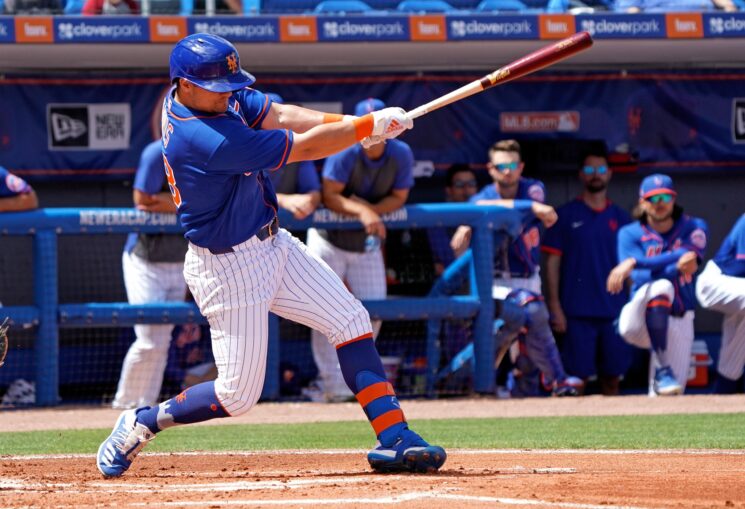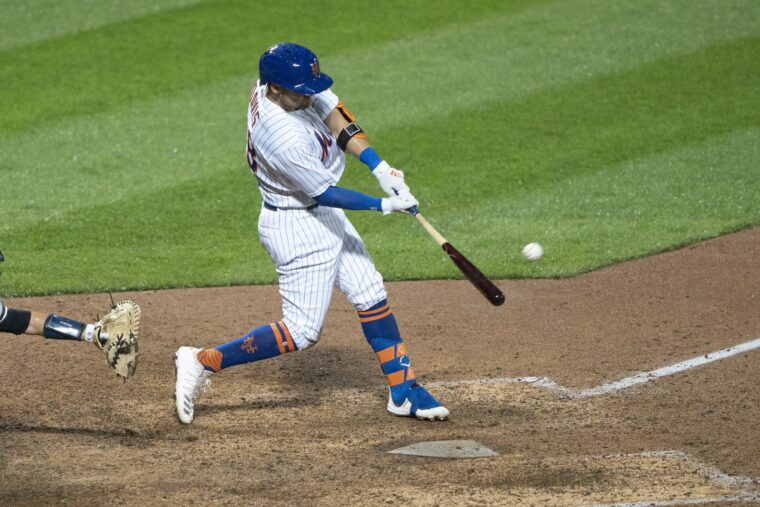After being acquired from the Houston Astros in 2019, third baseman J.D. Davis was able to break out in a massive way for the New York Mets and helped his team finish just a few games shy of a late-season playoff berth.
Looking to follow up on his impressive performance, the 27-year old entered this season with extremely high expectations but hasn’t been able to play up to them so far. As a result of the shortened 2020 campaign, several hitters across the league haven’t had opportunities to make adjustments at the plate over the summer, which has undoubtedly impacted Davis’ second season in Queens.
Positioned within the middle of the Mets’ lineup, manager Luis Rojas and his staff were hopeful he’d serve as a valuable run producer this season and help fill the void without veteran Yoenis Cespedes. Unfortunately, the former third-round pick has struggled mightily with runners in scoring position and hasn’t found a way to replicate his outstanding power numbers from last season.

In 2019, Davis earned 453 plate appearances, producing 22 doubles, 22 home runs, 57 RBIs, .220 ISO, .355 BABIP, .373 wOBA, 8.4% walk rate, 21.4% strikeout rate, 22.9% LD rate, 47% GB rate, 30.2% FB rate, 41.3% hard-hit rate, 136 wRC+ score, 2.4 fWAR rating, and a slashing line of .307/.369/.527/.895.
Adding to this, the right-hander also proved to be very effective with runners in scoring position during his inaugural season in New York. Through 123 plate appearances, he recorded four doubles, three home runs, 31 RBIs, .143 ISO, .312 BABIP, .318 wOBA, 11.4% walk rate, 21.9% strikeout rate, 25% LD rate, 40% GB rate, 35% FB rate, 41.3% hard-hit rate, 100 wRC+ score, along with a slashing line of .257/.350/.400/.750.
In comparison, Davis has received 181 plate appearances this season, creating six doubles, five home runs, 16 RBIs, .138 ISO, .327 BABIP, .344 wOBA, 11.6% walk rate, 22.7% strikeout rate, 19.6% LD rate, 55.4% GB rate, 25% FB rate, 36.6% hard-hit rate, 119 wRC+ score, 0.4 fWAR rating, and a slashing line of .263/.376/.401/.777.
Putting his struggles into perspective, the California State product’s woes have been highlighted, and not in a good way, with runners on third and/or second base. Over 41 plate appearances, the 6-foot-3 third baseman has generated just one double, one home run, nine RBIs, .118 ISO, .238 BABIP, .257 wOBA, 12.2% walk rate, 31.7% strikeout rate, 13.6% LD rate, 59.1% GB rate, 27.3% FB rate, 36.4% hard-hit rate, 61 wRC+ score, along with a measly slashing line of .176/.293/.294/.587.
With Davis struggling as a run producer, the Mets as a whole have also endured plenty of headaches with runners in scoring position through 47 games this season. As a result, they’ve been considered one of the worst run-scoring teams in the major leagues, which certainly hasn’t taken any pressure off their pitching staff.

Among all 30 teams in the majors, the Mets currently own the fifth-lowest AVG (.243) and OPS (.720), the sixth-lowest wRC+ score (95), the eighth-lowest hard-hit rate (31.8%), and they’re tied for the ninth-lowest BABIP (.284) and the third-lowest LD rate (19.4%) with RISP, according to FanGraphs.com.
While not all the blame can be placed on Davis, as first baseman Pete Alonso has failed to deliver in key situations several times, the California native still hasn’t found a way to turn his season around and time is starting to run out for him and his teammates.
So is the former Astro’s season salvageable at this point? Yes, but it still might not be enough to help the Mets claim a playoff spot before the end of September.
Compared to last season, Davis’ launch angle has decreased by 5.9 degrees this season and it has caused him to struggle mightily against fastballs and breaking balls. While a lower launch angle has worked for some players, namely Luis Guillorme, this approach has definitely hindered No. 28’s ability to succeed in the batter’s box.
During the 2019 campaign, the “Sun Bear” produced an average launch of eight degrees, recording 13 home runs, .322 AVG, .319 xAVG, .530 SLG, .546 xSLG, .398 wOBA, .406 xwOBA, and a 10.9% barrel rate against heaters.
But this season, he’s seen his average launch angle drop to four degrees, producing just four home runs, .295 AVG, .304 xAVG, .453 SLG, .479 xSLG, .374 wOBA, .394 xwOBA, and a 5.5% barrel rate against them.

As for breaking balls, Davis increased his average launch angle to 14 degrees against them last season, which resulted in six home runs, .313 AVG, .323 xAVG, .563 SLG, .605 xSLG, .357 wOBA, .382 xwOBA, along with a 12.7% barrel rate.
Similar to his approach against fastballs, he has reduced his average launch angle to four degrees against curveballs and sliders in 2020, which has led to just one home run, .172 AVG, .242 xAVG, .276 SLG, .458 xSLG, .248 wOBA, .340 xwOBA, and a 9.5% barrel rate.

Based on these concerning metrics, it’s clear Davis needs to adjust his swing path and recreate his approach from the 2019 campaign. But with just 13 games remaining, accomplishing that feat in 13 days will likely prove to be difficult for the Mets’ third baseman.
The good news? The former outfielder’s single on Sep. 11 was hit against a sinking fastball, that generated a 32 degrees launch angle. While he has averaged a zero degree launch angle against heaters over his last seven plate appearances, it seems like he could be starting to turn the corner very shortly and could potentially be on the verge of a hot streak.
Despite the challenging task that’s ahead of him, if Davis can increase his launch angle over this final stretch in the regular season, there’s a very good chance he could catch fire and carry his team’s lineup. If successful, they could become one of the most potent offenses in the league to finish the month.
With the Mets currently two games shy of the final Wild Card spot, they’ll need a late push to miraculously surge into the postseason for the first time since 2016. In order to accomplish that goal, the offense will need to provide consistent run support for their struggling pitching staff, aside from Jacob deGrom of course.
















